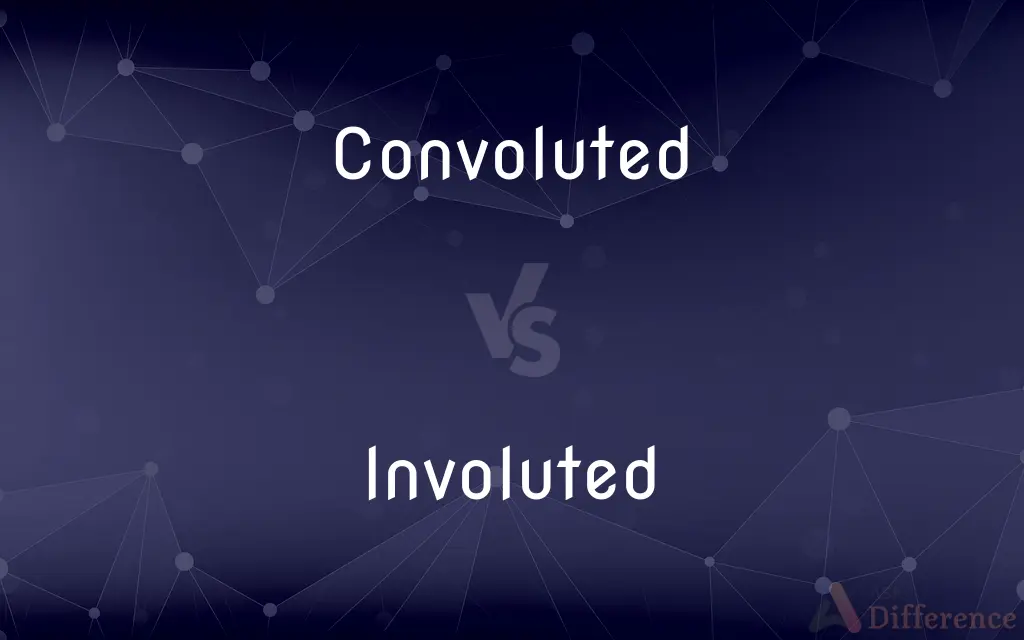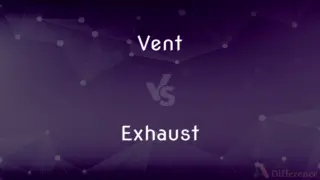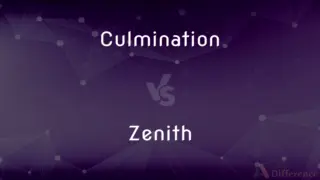Convoluted vs. Involuted — What's the Difference?
Edited by Tayyaba Rehman — By Maham Liaqat — Updated on April 2, 2024
Convoluted describes something complex and difficult to follow, often unnecessarily so, while involuted refers to something that has become overly complicated, often involving an inward complexity or intricacy.

Difference Between Convoluted and Involuted
Table of Contents
ADVERTISEMENT
Key Differences
Convoluted is used to describe situations, explanations, designs, or anything else characterized by unnecessary complexity and confusion. It implies a level of complexity that makes understanding or interpretation difficult. On the other hand, involuted denotes a state of being complex, but with a nuance towards having internal convolutions or being intricately folded or coiled within. This term often suggests an inward complexity that may not always be immediately apparent from the outside.
While a convoluted argument might be hard to follow due to its winding and complex nature, an involuted argument might fold back on itself in complexity, becoming difficult to unravel because of its intricate inner connections. Convoluted often carries a negative connotation, suggesting that something is more complicated than it needs to be. Conversely, involuted, although it can also carry a negative connotation, might be used in contexts where complexity adds to depth or intricacy, especially in natural or artistic patterns.
In literature or speech, convoluted sentences are those with excessive twists and turns of phrase that obscure meaning. In contrast, involuted writing might use complex structures and references that loop back on themselves, requiring a deeper understanding or analysis to appreciate fully. Convoluted designs may confuse or overwhelm with their complexity, whereas involuted designs could fascinate or intrigue through their layered or detailed complexity.
The distinction between convoluted and involuted often lies in the perception of complexity: convoluted is externally complex and often unnecessarily so, making something harder to understand or follow. In contrast, involuted implies a complexity that is more intrinsic, sometimes purposeful, and requires introspection or detailed observation to understand its full depth.
Comparison Chart
Definition
Characterized by unnecessary complexity and confusion.
Having intricate inner workings or complexity.
ADVERTISEMENT
Connotation
Generally negative, implying overcomplication.
Can be negative or neutral, emphasizing depth or intricacy.
Usage in Text
Describes texts or speeches that are hard to follow.
Refers to texts or designs with complex, often inward, intricacy.
Perception
Externally complex and often viewed as overly complicated.
Complexity is more intrinsic and may require detailed observation.
Examples
A convoluted storyline in a movie.
An involuted philosophical argument or a complex natural pattern.
Compare with Definitions
Convoluted
Convoluted describes something unnecessarily complex.
The plot of the movie was so convoluted that viewers found it hard to follow.
Involuted
Involuted refers to something complex and intricately folded or coiled.
The novel’s involuted narrative structure requires careful reading to understand.
Convoluted
It often pertains to speech or writing that is winding and difficult to understand.
The lecture was filled with convoluted explanations that confused the students.
Involuted
It can describe designs or patterns with detailed internal complexity.
The artist’s involuted sketches captured the viewers' fascination.
Convoluted
Convoluted solutions or methods are seen as overly complicated.
The new tax law is a convoluted system that few can navigate easily.
Involuted
Involuted arguments have a depth that may loop back on themselves.
The philosopher’s involuted discussions on ethics demand a high level of intellectual engagement.
Convoluted
This term can imply a complexity that detracts from clarity or purpose.
The software’s convoluted user interface discouraged new users.
Involuted
This term suggests a complexity that has an inward focus.
The involuted mechanisms of the clock are a masterpiece of engineering.
Convoluted
Convoluted arguments are marked by unnecessary twists and turns.
His convoluted reasoning made it difficult to grasp his main point.
Involuted
Involuted can also imply a maturity or evolution towards complexity.
The musician’s latest work is an involuted exploration of classical and modern themes.
Convoluted
Having numerous overlapping coils or folds
A convoluted seashell.
Involuted
Intricate; complex.
Convoluted
Intricate; complicated
Convoluted legal language.
Convoluted reasoning.
Involuted
(Botany)Having the margins rolled inward.
Convoluted
Having numerous overlapping coils or folds; convolute.
Involuted
(Zoology)Having whorls that enclose and obscure earlier whorls. Used of a gastropod shell.
Convoluted
(figuratively) Complex, complicated, or intricate.
He gave a convoluted explanation that amounted to little more than a weak excuse for his absence.
Involuted
To curl inward.
Convoluted
Simple past tense and past participle of convolute
Involuted
The curve traced by a point as if it were on a taut string being unwound from another curve.
Convoluted
Having convolutions.
Beaks recurved and convoluted like a ram's horn.
Involuted
Simple past tense and past participle of involute
Convoluted
Folded in tortuous windings.
A highly convoluted brain.
Convoluted
Rolled or coiled together;
A convoluted shell
Convoluted
Highly involved or intricate;
The Byzantine tax structure
Convoluted legal language
Convoluted reasoning
Intricate needlework
An intricate labyrinth of refined phraseology
The plot was too involved
A knotty problem
Got his way by labyrinthine maneuvering
Oh, what a tangled web we weave
Tortuous legal procedures
Tortuous negotiations lasting for months
Common Curiosities
Can a narrative be both convoluted and involuted?
Yes, a narrative can be both if it features a complex and difficult-to-follow structure (convoluted) with intricate and deep internal connections (involuted).
Why might someone prefer an involuted design?
Someone might prefer an involuted design for its depth, intricacy, and the intellectual or aesthetic engagement it requires to fully appreciate its complexity.
What is the main difference between convoluted and involuted?
Convoluted implies unnecessary or over-complication, making something difficult to follow, while involuted suggests an intricate or complex inward design or argument, often with a layer of depth.
Can technology be described as convoluted or involuted?
Yes, technology can be described as convoluted if it’s unnecessarily complicated for users to navigate or as involuted if it has complex, sophisticated systems that require detailed understanding.
How can one simplify a convoluted explanation?
Simplifying a convoluted explanation involves breaking it down into simpler, more straightforward components, avoiding unnecessary digressions, and using clear and concise language.
What makes writing involuted rather than just complex?
Writing becomes involuted when its complexity involves intricate structures or ideas that loop back on themselves, requiring deep analysis to untangle, beyond just being complex.
How can designers avoid creating convoluted products?
Designers can avoid creating convoluted products by focusing on user experience, prioritizing simplicity and intuitiveness, and avoiding unnecessary features or complications.
How does one approach understanding an involuted argument?
Understanding an involuted argument requires patience, careful analysis, and sometimes background knowledge to appreciate the layers of meaning and connections within.
Is involuted complexity always negative?
Not necessarily. In some contexts, such as in art or natural patterns, involuted complexity can add to the depth and fascination of the subject.
Are convoluted problems harder to solve than involuted ones?
Convoluted problems might be difficult to solve due to their unnecessary complexity and lack of clarity, whereas involuted problems may require deeper insight but potentially offer a clearer path to solution once understood.
Share Your Discovery

Previous Comparison
Vent vs. Exhaust
Next Comparison
Culmination vs. ZenithAuthor Spotlight
Written by
Maham LiaqatEdited by
Tayyaba RehmanTayyaba Rehman is a distinguished writer, currently serving as a primary contributor to askdifference.com. As a researcher in semantics and etymology, Tayyaba's passion for the complexity of languages and their distinctions has found a perfect home on the platform. Tayyaba delves into the intricacies of language, distinguishing between commonly confused words and phrases, thereby providing clarity for readers worldwide.
















































